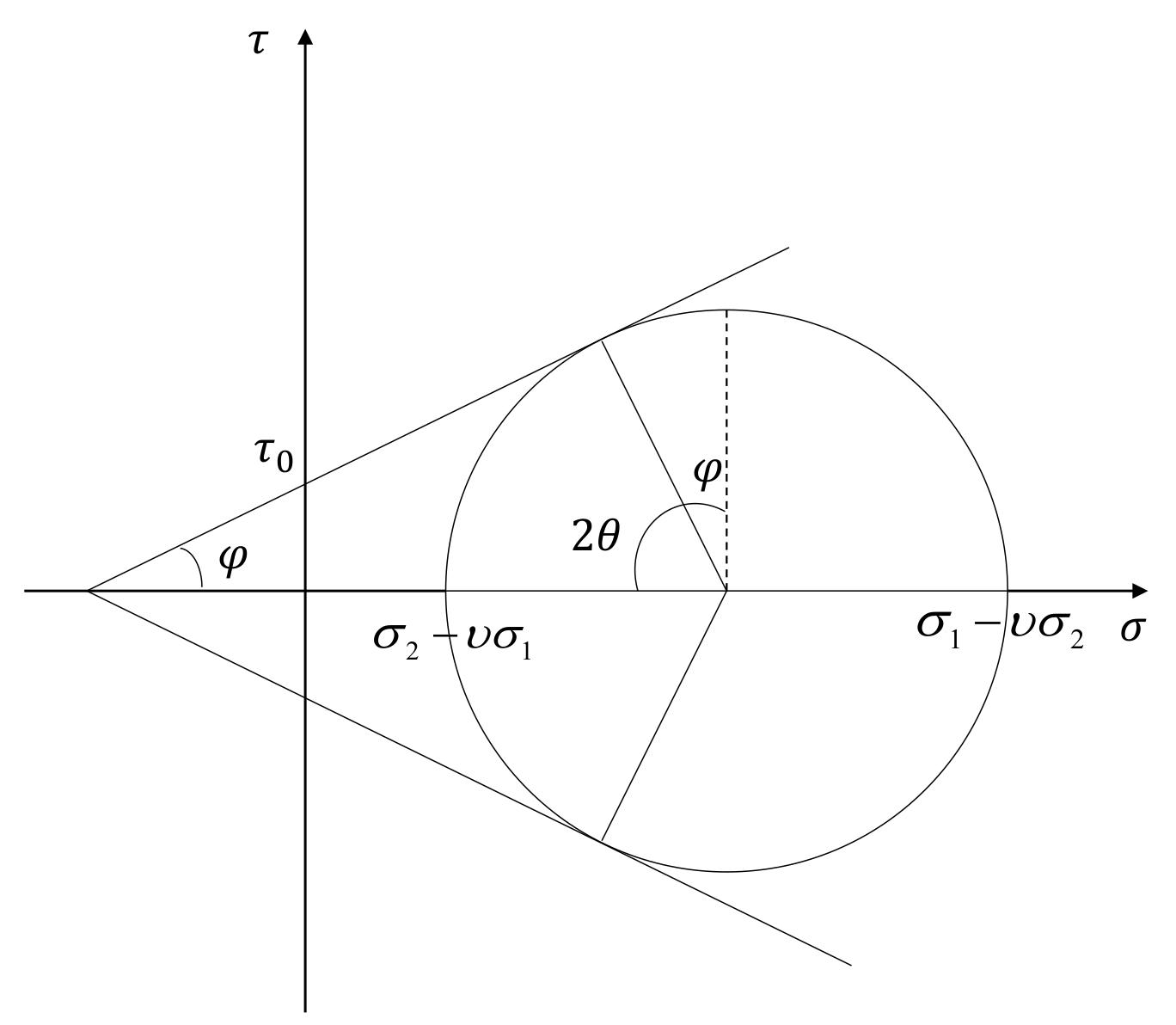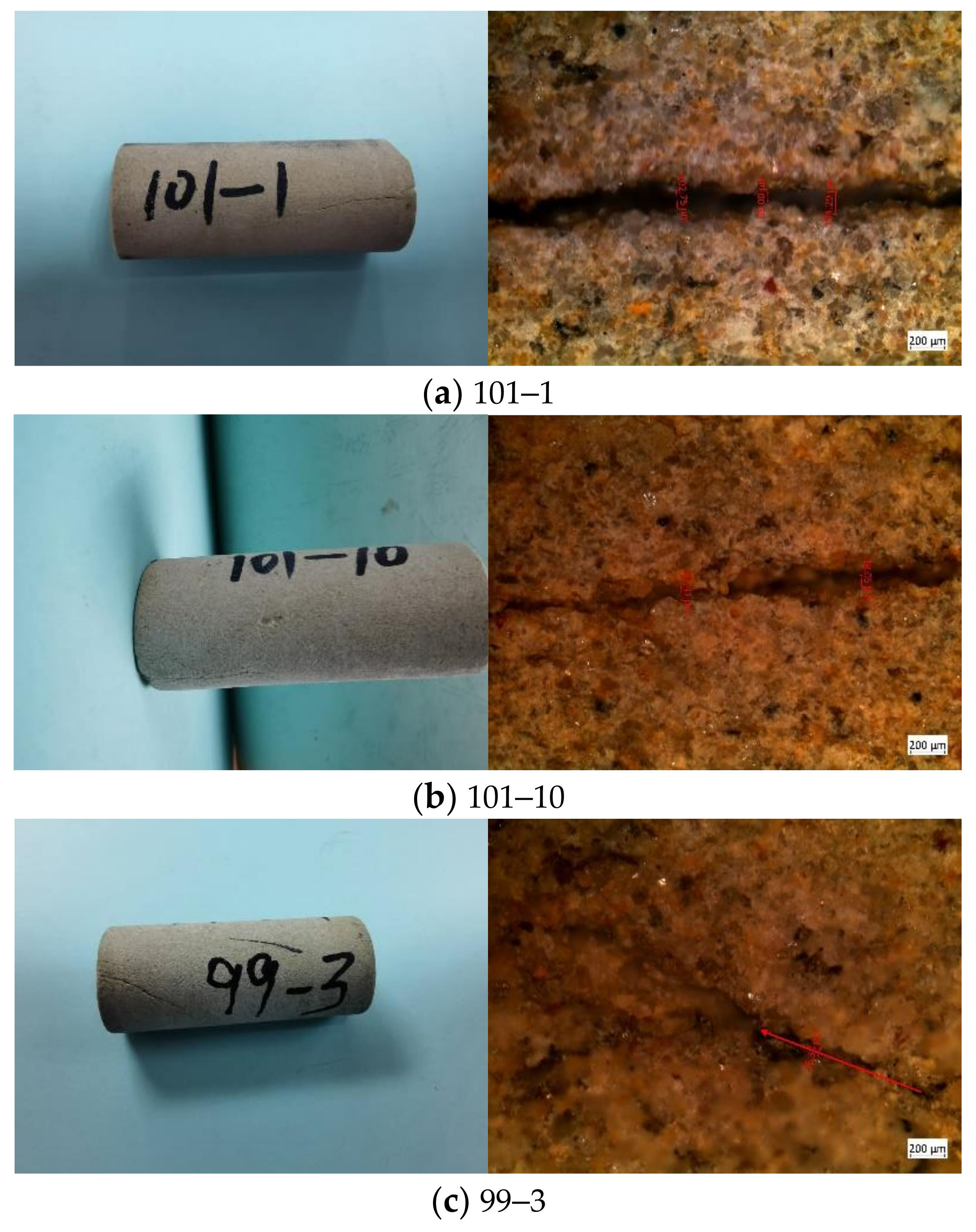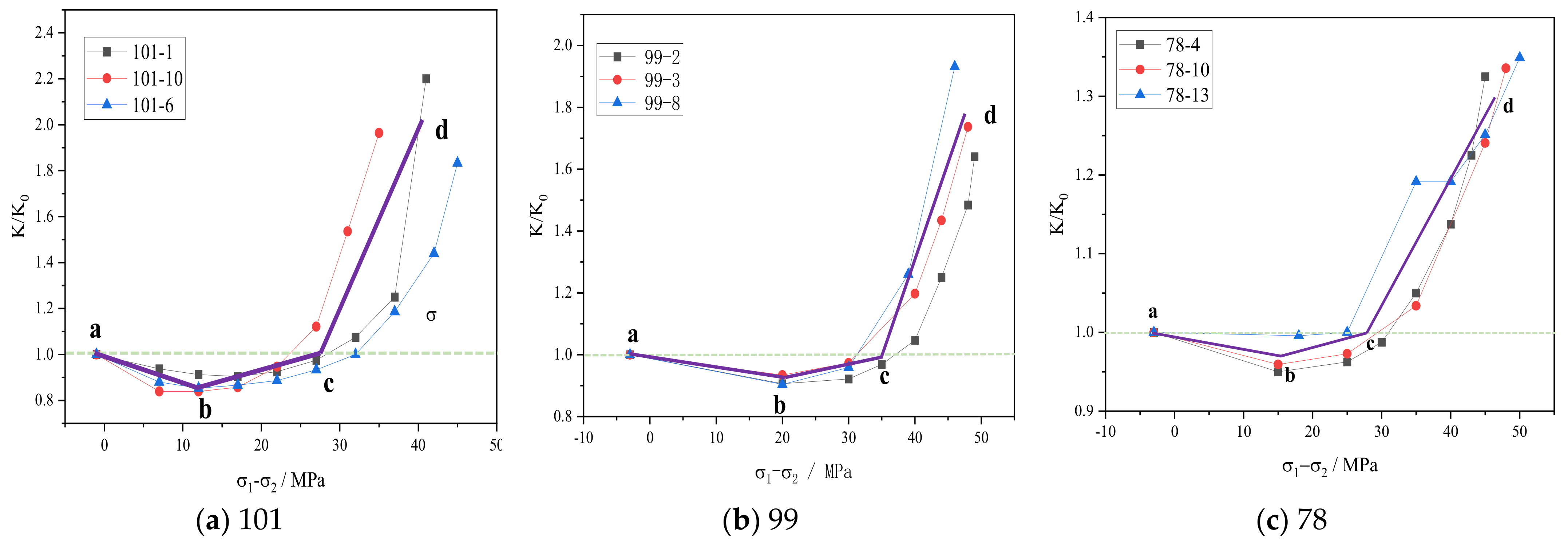The Establishment and Evaluation Method of Artificial Microcracks in Rocks
Abstract
1. Introduction
2. Samples and Experiments
2.1. Rock Rupture Principle
2.2. Samples and Experiments
- (1)
- Connect the experimental instrument, test the airtightness of the device, and select the core for drying treatment;
- (2)
- Load a small axial pressure first, fix the core position, and then load a fixed confining pressure, and it will always remain unchanged;
- (3)
- Open the gas cylinder, set a suitable gas drive pressure, and always keep it constant; Use a gas flow meter to test the gas flow rate at the outlet end of the core holder in order to calculate the real-time permeability of the core;
- (4)
- Set the axial pressure from 0, to 5 MPa, to 10 MPa, to 15 MPa, etc., until the gas permeability growth rate increases rapidly. At this time, increase the axial pressure growth in 1 MPa increments until the permeability is at an ideal level. When a certain axial pressure is loaded, keep the axial pressure constant; when the permeability does not change over time, increase the axial pressure. Different permeability growth rates represent different degrees of microcrack development;
- (5)
- Change the confining pressure, repeat step 4, and compare the effect of confining pressure on the result of making microcracks;
- (6)
- End the experiment and process the experimental data.
3. Results and Discussion
3.1. NMR T2 Spectrum Characteristics and Porosity Changes
3.2. Observation under the Microscope
3.3. The Evaluation Method of Artificial Microcracks in Rocks
3.4. Case Application
4. Conclusions
- (1)
- A complete crack-making and evaluation method was established. This method can produce cores with any degree of microcrack development for the seepage experiments. According to theoretical calculations and experimental results, the resulting crack angle was 20–27.5° with the axis, and visible cracks appeared on the surface when the fracture permeability increased by more than 90%, where the visible cracks had a width of 60–100 μm. Furthermore, this method is highly reproducible and low in cost.
- (2)
- The greater the confining pressure, the less prone to microcracks. It is easier to form microcracks when considering deformation than without considering deformation. The permeability variation curve shows two obvious turning points, which divide the whole zone into a reduction zone, a slow increase zone, and a rapid increase zone. The drop in permeability in the rock compaction stage generally does not exceed 15%, and the greater the initial rock permeability, the smaller the impact of the compaction stage on the permeability.
- (3)
- The smaller the initial permeability of the rock, the higher the contribution rate of the microcracks to the seepage capacity, because the microcracks become the main channel of porous media, as shown by the T2 curve of the cracked core shifting to the right, the storage space somewhat increasing, and the enhanced signal volume.
Author Contributions
Funding
Institutional Review Board Statement
Informed Consent Statement
Data Availability Statement
Conflicts of Interest
References
- Zhou, X.; Yuan, Q.; Zhang, Y.; Wang, H.; Zeng, F.; Zhang, L. Performance evaluation of CO2 flooding process in tight oil reservoir via experimental and numerical simulation studies. Fuel 2019, 236, 730–746. [Google Scholar] [CrossRef]
- Wang, X.; Hou, J.; Song, S.; Wang, D.; Gong, L.; Ma, K.; Liu, Y.; Li, Y.; Yan, L. Combining pressure-controlled porosimetry and rate-controlled porosimetry to investigate the fractal characteristics of full-range pores in tight oil reservoirs. J. Pet. Sci. Eng. 2018, 171, 353–361. [Google Scholar] [CrossRef]
- Zhao, P.; Wang, Z.; Sun, Z.; Cai, J.; Wang, L. Investigation on the pore structure and multifractal characteristics of tight oil reservoirs using NMR measurements: Permian Lucaogou Formation in Jimusaer Sag, Junggar Basin. Mar. Pet. Geol. 2017, 86, 1067–1081. [Google Scholar] [CrossRef]
- Wang, G.; Chang, X.; Yin, W.; Li, Y.; Song, T. Impact of diagenesis on reservoir quality and heterogeneity of the Upper Triassic Chang 8 tight oil sandstones in the Zhenjing area, Ordos Basin, China. Mar. Pet. Geol. 2017, 83, 84–96. [Google Scholar] [CrossRef]
- Li, P.; Zheng, M.; Bi, H.; Wu, S.; Wang, X. Pore throat structure and fractal characteristics of tight oil sandstone: A case study in the Ordos Basin, China. J. Pet. Sci. Eng. 2017, 149, 665–674. [Google Scholar] [CrossRef]
- Bai, R.; Li, Z.; Wang, H.; Liu, X.; Wei, Q.; Li, H. Fractal nature of microscopic pore throat structure in Chang 7 tight oil reservoir of Longdong area. Sci. Technol. Eng. 2016, 16, 54–59. [Google Scholar]
- Giri, A.; Tarafdar, S.; Gouze, P.; Dutta, T. Fractal pore structure of sedimentary rocks: Simulation in 2-d using a relaxed bidisperse ballistic deposition model. J. Appl. Geophys. 2012, 87, 40–45. [Google Scholar] [CrossRef]
- Kaiming, W. The prospect of exploration and development for unconventional hydrocarbon resources in China. World Well Logging Technol. 2009, 3, 8. [Google Scholar]
- Du, S. Characteristics and the formation mechanism of the heterogeneous microfractures in the tight oil reservoir of Ordos Basin, China. J. Pet. Sci. Eng. 2020, 191, 107176. [Google Scholar] [CrossRef]
- Yang, B.; Qu, H.; Pu, R.; Tian, X.; Yang, H.; Dong, W.; Chen, Y. Controlling Effects of Tight Reservoir Micropore Structures on Seepage Ability: A Case Study of the Upper Paleozoic of the Eastern Ordos Basin, China. Acta Geol. Sin. 2019, 94, 322–336. [Google Scholar] [CrossRef]
- Du, S.; Zhao, Y.; Yuan, Q. Prediction of permeability and its anisotropy of tight oil reservoir via precise pore-throat tortuosity characterization and “umbrella deconstruction” method. J. Pet. Sci. Eng. 2019, 178, 1018–1028. [Google Scholar] [CrossRef]
- Shedid, S. Influences of fracture orientation on oil recovery by water and polymer flooding processes: An experimental approach. J. Pet. Sci. Eng. 2006, 50, 285–292. [Google Scholar] [CrossRef]
- Eoff, L.S.; Dalrymple, E.D.; Everett, D.M.; Vasquez, J.E. Worldwide Field Applications of a Polymeric Gel System for Conformance Applications. SPE Prod. Oper. 2007, 22, 231–235. [Google Scholar] [CrossRef]
- Simjoo, M.; Koohi, A.D.; Seftie, M.V.; Zitha, P.L.J. Water Shut-Off in a Fractured System Using a Robust Polymer Gel. In Proceedings of the Society of Petroleum Engineers 8th European Formation Damage Conference, Scheveningen, The Netherlands, 27–29 May 2009. [Google Scholar] [CrossRef]
- Lian, P.; Cheng, L. The Characteristics of Relative Permeability Curves in Naturally Fractured Carbonate Reservoirs. J. Can. Pet. Technol. 2012, 51, 137–142. [Google Scholar] [CrossRef]
- Katsuki, D.; Gutierrez, M.; Almrabat, A. Stress-dependent shear wave splitting and permeability in fractured porous rock. J. Rock Mech. Geotech. Eng. 2019, 11, 1–11. [Google Scholar] [CrossRef]
- Chitrala, Y.; Moreno, C.; Sondergeld, C.H.; Rai, C.S. An experimental investigation into hydraulic fracture propagation under different applied stresses in tight sands using acoustic emissions. J. Pet. Sci. Eng. 2013, 108, 151–161. [Google Scholar] [CrossRef]
- Martin, C.; Chandler, N. The progressive fracture of Lac du Bonnet granite. Int. J. Rock Mech. Min. Sci. Geomech. Abstr. 1994, 31, 643–659. [Google Scholar] [CrossRef]
- Fonseka, G.; Murrell, S.; Barnes, P. Scanning electron microscope and acoustic emission studies of crack development in rocks. Int. J. Rock Mech. Min. Sci. Geomech. Abstr. 1985, 22, 273–289. [Google Scholar] [CrossRef]
- Yang, S.-Q.; Yin, P.-F.; Huang, Y.-H.; Cheng, J.-L. Strength, deformability and X-ray micro-CT observations of transversely isotropic composite rock under different confining pressures. Eng. Fract. Mech. 2019, 214, 1–20. [Google Scholar] [CrossRef]
- Zhang, Y.; Niu, S.; Du, Z.; Hao, J.; Yang, J. Dynamic fracture evolution of tight sandstone under uniaxial compression in high resolution 3D X-ray microscopy. J. Pet. Sci. Eng. 2020, 195, 107585. [Google Scholar] [CrossRef]
- Torsaeter, O.; Kleppe, J.; Van Golf-Racht, T. Multiphase Flow in Fractured Reservoirs. Advances in Transport Phenomena in Porous Media; Springer: Dordrecht, The Netherlands, 1987; pp. 551–629. [Google Scholar]
- Liu, B.; Yang, Y.; Li, J.; Chi, Y.; Li, J.; Fu, X. Stress sensitivity of tight reservoirs and its effect on oil saturation: A case study of Lower Cretaceous tight clastic reservoirs in the Hailar Basin, Northeast China. J. Pet. Sci. Eng. 2020, 184, 106484. [Google Scholar] [CrossRef]
- Liu, B.; Song, Y.; Zhu, K.; Su, P.; Ye, X.; Zhao, W. Mineralogy and element geochemistry of salinized lacustrine organic-rich shale in the Middle Permian Santanghu Basin: Implications for paleoenvironment, provenance, tectonic setting and shale oil potential. Mar. Pet. Geol. 2020, 120, 104569. [Google Scholar] [CrossRef]
- Hudson, J.; Popescu, M.; Harrison, J. Engineering Rock Mechanics: An Introduction to the Principles. Appl. Mech. Rev. 2002, 55, B30. [Google Scholar] [CrossRef]
- Shen, B.; Shi, J.; Barton, N. An approximate nonlinear modified Mohr-Coulomb shear strength criterion with critical state for intact rocks. J. Rock Mech. Geotech. Eng. 2018, 10, 645–652. [Google Scholar] [CrossRef]
- Gu, J.; Li, K.; Su, L. Modified nonlinear Mohr–Coulomb fracture criteria for isotropic materials and transversely isotropic UD composites. Mech. Mater. 2020, 151, 103649. [Google Scholar] [CrossRef]
- Abbo, A.; Lyamin, A.; Sloan, S.; Hambleton, J. A C2 continuous approximation to the Mohr-Coulomb yield surface. Int. J. Solids Struct. 2011, 48, 3001–3010. [Google Scholar] [CrossRef]
- Wan, Y.; Zhang, H.; Liu, X.; Yin, G.; Xiong, J.; Liang, L. Prediction of mechanical parameters for low-permeability gas reservoirs in the Tazhong Block and its applications. Adv. Geo Energy Res. 2020, 4, 219–228. [Google Scholar] [CrossRef]
- Barton, N. The shear strength of rock and rock joints. Int. J. Rock Mech. Min. Sci. Geomech. Abstr. 1976, 13, 255–279. [Google Scholar] [CrossRef]
- Barton, N. Shear strength criteria for rock, rock joints, rockfill and rock masses: Problems and some solutions. J. Rock Mech. Geotech. Eng. 2013, 5, 249–261. [Google Scholar] [CrossRef]
- Li, X.; Lu, D.; Luo, R.; Sun, Y.; Shen, W.; Hu, Y.; Liu, X.; Qi, Y.; Guan, C.; Guo, H. Quantitative criteria for identifying main flow channels in complex porous media. Pet. Explor. Dev. 2019, 46, 998–1005. [Google Scholar] [CrossRef]
- Li, X.; Luo, R.; Xu, X.; Xu, X.; Jiao, C.; Guo, Z.; Wan, Y.; Liu, X.; Li, Y. Main flow channel index in porous sand reservoirs and its application. Pet. Explor. Dev. 2020, 47, 1055–1061. [Google Scholar] [CrossRef]
- Lyu, C.; Wang, Q.; Ning, Z.; Chen, M.; Li, M.; Chen, Z.; Xia, Y. Investigation on the application of NMR to spontaneous imbibition recovery of tight sandstones: An experimental study. Energies 2018, 11, 2359. [Google Scholar] [CrossRef]
- Lai, F.; Li, Z.; Wei, Q.; Zhang, T.; Zhao, Q. Experimental investigation of spontaneous imbibition in a tight reservoir with nuclear magnetic resonance testing. Energy Fuels 2016, 30, 8932–8940. [Google Scholar] [CrossRef]
- Lei, G.; Liao, Q.; Patil, S.; Zhao, Y. Effect of clay content on permeability behavior of argillaceous porous media under stress dependence: A theoretical and experimental work. J. Pet. Sci. Eng. 2019, 179, 787–795. [Google Scholar] [CrossRef]
- Lei, G.; Dong, P.; Wu, Z.; Mo, S.; Gai, S.; Zhao, C.; Liu, Z. A Fractal Model for the Stress-Dependent Permeability and Relative Permeability in Tight Sandstones. J. Can. Pet. Technol. 2015, 54, 36–48. [Google Scholar] [CrossRef]
- Zhang, T.; Li, Z.; Adenutsi, C.D.; Lai, F. A new model for calculating permeability of natural fractures in dual-porosity reservoir. Adv. Geo-Energy Res. 2017, 1, 86–92. [Google Scholar] [CrossRef]
- Luo, Y.; Xia, B.; Li, H.; Hu, H.; Wu, M.; Ji, K. Fractal permeability model for dual-porosity media embedded with natural tortuous fractures. Fuel 2021, 295, 120610. [Google Scholar] [CrossRef]










| Whether to Consider the Deformation | Confining Pressure (MPa) | Whether Damage Occurred | Poisson’s Ratio υ | |
| a | N | 5 | N | 0.3 |
| b | Y | 5 | Y | 0.3 |
| c | Y | 10 | N | 0.3 |
| Core Number | Length (cm) | Diameter (cm) | Porosity (%) | Permeability (10−3 μm2) (before Crack Creation) | Permeability (10−3 μm2) (after Crack Creation) | The Growth Rate of Permeability (%) |
|---|---|---|---|---|---|---|
| 101–1 | 6.043 | 2.501 | 13.17 | 0.1459 | 0.3210 | 120 |
| 101–6 | 6.08 | 2.476 | 12.58 | 0.0937 | 0.1718 | 83 |
| 101–10 | 6.037 | 2.485 | 11.23 | 0.1723 | 0.3385 | 96 |
| 99–2 | 6.07 | 2.465 | 13.23 | 0.4025 | 0.6603 | 64 |
| 99–3 | 6.03 | 2.469 | 12.62 | 0.4733 | 0.8220 | 93 |
| 99–8 | 6.017 | 2.476 | 12.56 | 0.4510 | 0.8712 | 74 |
| 78–4 | 6.021 | 2.455 | 11.46 | 1.5031 | 1.9991 | 33 |
| 78–10 | 6.119 | 2.466 | 11.98 | 1.5687 | 2.1021 | 34 |
| 78–13 | 6.03 | 2.455 | 12.15 | 1.4802 | 1.9983 | 35 |
| Core Number | Diameter (cm) | Length (cm) | Permeability (10−3 μm2) | The Growth Rate of Permeability (%) |
|---|---|---|---|---|
| 112–1 | 2.50 | 8.02 | 0.2878 | 22.56% |
| 112–2 | 2.51 | 8.06 | 0.2821 | 35.04% |
| 112–3 | 2.49 | 7.55 | 0.2360 | 45.33% |
| 112–4 | 2.50 | 7.97 | 0.2727 | 52.89% |
| 112–5 | 2.52 | 7.96 | 0.2533 | 63.14% |
| 112–6 | 2.50 | 7.89 | 0.2606 | 76.40% |
| 112–7 | 2.53 | 8.08 | 0.2039 | 86.33% |
| 112–8 | 2.54 | 7.79 | 0.1869 | 93.99% (Visible cracks) |
Publisher’s Note: MDPI stays neutral with regard to jurisdictional claims in published maps and institutional affiliations. |
© 2021 by the authors. Licensee MDPI, Basel, Switzerland. This article is an open access article distributed under the terms and conditions of the Creative Commons Attribution (CC BY) license (https://creativecommons.org/licenses/by/4.0/).
Share and Cite
Wu, Z.; Li, X.; Xiao, H.; Liu, X.; Lin, W.; Rao, Y.; Li, Y.; Zhang, J. The Establishment and Evaluation Method of Artificial Microcracks in Rocks. Energies 2021, 14, 2780. https://doi.org/10.3390/en14102780
Wu Z, Li X, Xiao H, Liu X, Lin W, Rao Y, Li Y, Zhang J. The Establishment and Evaluation Method of Artificial Microcracks in Rocks. Energies. 2021; 14(10):2780. https://doi.org/10.3390/en14102780
Chicago/Turabian StyleWu, Zhenkai, Xizhe Li, Hanmin Xiao, Xuewei Liu, Wei Lin, Yuan Rao, Yang Li, and Jie Zhang. 2021. "The Establishment and Evaluation Method of Artificial Microcracks in Rocks" Energies 14, no. 10: 2780. https://doi.org/10.3390/en14102780
APA StyleWu, Z., Li, X., Xiao, H., Liu, X., Lin, W., Rao, Y., Li, Y., & Zhang, J. (2021). The Establishment and Evaluation Method of Artificial Microcracks in Rocks. Energies, 14(10), 2780. https://doi.org/10.3390/en14102780







